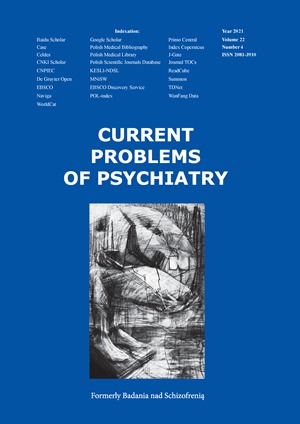Inkblots as a cultural phenomenon:On the centenary of the Rorschach test
DOI:
https://doi.org/10.2478/cpp-2021-0018Keywords:
Rorschach test, cultural determinants, theory of signs, phenomenology of perceptionAbstract
Introduction. Approved or not, the Hermann Rorschach test can be considered more than just a test to a clinical trial. Reflection on it as a broader phenomenon may yield what is the most valuable: better knowledge of human nature.
Objective. This article aims to present the dual nature of Rorschach's inkblots: as a test of "guessing" the meaning of signs and as a test of perception.
Method. Narrative literature review on the meaning and interpretation of the Rorschach test.
Results.
The nature and reception of inkblots. The inkblots have a dual nature: they require visual perception, and at the same time they are signs, whose meanings are extracted in the process of interpretation. This process is largely subject to cultural determinants; it also depends on the structure of stimuli and on their artistic expression.
Charles Sanders Peirce’s theory of signs and the sign nature of inkblots. According to Peirce, the interpretation of a sign, as a triadic structure, belongs to the ontic order and is a continuous process, taking place perpetually. Mental interpretation, as it were, follows the ontic dimension and constitutes a kind of reflection of this dimension.
The phenomenology of perception and the interpretation of inkblots. Perception as viewed by Rorschach found its unintended, though strikingly consistent, complement in the philosophy of Maurice Merleau-Ponty. This is particularly clear in the acknowledgment of the role of the body in perception and in emphasis placed on the active and dynamic nature of the subject– object relationship.
Rorschach and Merleau-Ponty vs. Peirce: similarities and differences. The seemingly completely different ways of understanding interpretation in Peirce’s semiotics (indirect cognition) and in Merleau-Ponty’s phenomenology (direct cognition), actually show important similarities. I draw attention to the ontic dimension of interpretation and its systemic character, which both philosophers stress, and to the view of interpretation as a perpetual process that is never completed, both in Peirce’s semiotics and in Merleau-Ponty’s phenomenology.
Conclusion. The semiotic and perceptual nature of the inkblots created by the Swiss psychiatrist reflects two basic and mutually complementary ways in which humans experience the world. This experience has both a psychological and an ontic nature, which makes it possible for an examination using the Rorschach test to become an encounter with an existential dimension.
References
1. Exner JE. The Rorschach Comprehensive System. Hoboken, NJ; John Wiley and Sons: 2003.
2. Akavia N. Subjectivity in motion: Life, art, and movement in the work of Hermann Rorschach. New York, NY; Routledge: 2013.
3. Paluchowski WJ. Teoretyczna analiza i diagnostyczne znaczenie metody H. Rorschacha. In: Paluchowski WJ, ed., Z zagadnień diagnostyki osobowości. Warsaw, Kraków, Gdańsk, Łódź; Wydawnictwo PAN: 161-182.
4. Stasiakiewicz M. Podmiotowe i sytuacyjne wyznaczniki badania testem Rorschacha. Poznań; Wydawnictwo Naukowe UAM: 1994.
5. Searls D. The Inkblots. Hermann Rorschach, his iconic test, and the power of seeing. New York, NY; Crown Publishing Group: 2017.
6. Arnheim R. Visual thinking. Berkeley, Los Angeles, London; University of California Press: 1969.
7. Hunca-Bednarska A. Nieco inaczej o teście plam atramentowych Hermanna Rorschacha. Eseje. Lublin; Wydawnictwo KUL: 2013.
8. Leśniak FL. Perceptanaliza w perspektywie pozytywnej dezintegracji. Metoda Rorschacha dla zaawansowanych. Warsaw; PTHP: 1994.
9. Arnheim R. Sztuka i percepcja wzrokowa. Psychologia twórczego oka. Trans. Jolanta Mach. Warsaw; Wydawnictwo Artystyczne i Filmowe: 1978.
10. Mitchell T. Piśmienność wizualna czy wizualność piśmienna? Teksty Drugie, 2012; 133-134(1/2): 153-163.
11. Deręgowski JB. Oko i obraz. Studium psychologiczne. Trans. Krystyna Dudziak. Warsaw; PWN: 1990.
12. Rapaport D, Gill MM, Schafer R. Diagnostic psychological testing. New York, NY; International Universities Press: 1975.
13. Paluchowski WJ. Diagnoza psychologiczna. Podejście jakościowe i ilościowe. Seria Wykłady z psychologii, t. 7. Warsaw; Wydawnictwo Naukowe „Scholar”: 2001.
14. Durand G. Wyobraźnia symboliczna. Trans. Cezary Rowiński. Warsaw; PWN: 1986.
15. Hunca-Bednarska A. Koncepcja ruchu w teście Hermanna Rorschacha. Refleksje nad książką Naamah Akavii: Subjectivity in Motion. Life, Art, and Movement in the Work of Hermann Rorschach. Curr Probl Psychiatry, 2015; 16(2): 113-123.
16. Buczyńska-Garewicz H. Słowo wstępne: Semiotyka i filozofia Znaku. In: Bense M. Świat przez pryzmat znaku. Trans. Jan Garewicz. Warsaw; PIW: 1980: 5-42.
17. Hunca-Bednarska A. Skojarzenia werbalne w schizofrenii. Lublin; Wydawnictwo Czelej: 1997.
18. Guiraud D. Semantyka. Trans. Stanisław Cichowicz. Warsaw; Wiedza Powszechna: 1976.
19. Buczyńska-Garewicz H. Rozum szukający i błądzący. Eseje o filozofii i filozofach. Toruń; Wydawnictwo Adam Marszałek: 2007.
20. Buczyńska-Garewicz H. Znak, znaczenie, wartość. Szkice o filozofii amerykańskiej. Warsaw; Książka i Wiedza: 1975.
21. Kalaga W. Mgławice dyskursu. Kraków; Universitas: 2001.
22. Judycki St. Percepcja zmysłowa. https://www.kul.pl/materiałydo pobrania, 23.08.2021.
23. Malmgren H. Rorschach’s idea of a “movement” response in the light of recent philosophy and psychology of perception. Rorschachiana, 2000; 24(24), 1-27.
24. Merleau-Ponty M. Fenomenologia percepcji. Trans. Małgorzata Kowalska i Jacek Migasiński. Warszawa; Fundacja Aletheia: 2001.
25. Migasiński J. Fenomenologia Merleau-Ponty’ego. In: Merleau-Ponty. Fenomenologia percepcji. Trans. Małgorzata Kowalska & Jacek Migasiński. Warsaw; Fundacja Aletheia: 2001: 479-486.
26. Galison P. Image of self. In: Daston I, ed., Things that talk: Object lessons from art and science. New York, NY; Zone Books: 2008: 257-294.
27. Lechte J. Panorama współczesnej myśli humanistycznej. Od strukturalizmu do postmodernizmu. Trans. Tadeusz Baszniak. Warsaw; Książka i Wiedza: 1999.
Downloads
Published
Issue
Section
License
Copyright (c) 2021 Author

This work is licensed under a Creative Commons Attribution 4.0 International License.


